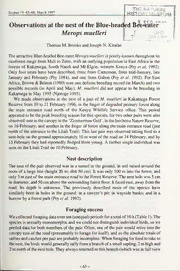
Observations at the nest of the blue-headed bee-eater Merops muelleri PDF
Preview Observations at the nest of the blue-headed bee-eater Merops muelleri
Scopus 19:65-68,March 1997 MSHMViilUSEUM Observations at the nest of the Blue-headled Merops muelleri J- \ ThomasM. Brooks andJosephN. Kirathe TheattractiveBlue-headedBee-eaterMeropsmuelleriispoorly-knownthroughoutits rainforestrange from Mali toZaire, withanoutlyingpopulation inEastAfricainthe forests ofKakamega, South Nandi and Mt Elgon, western Kenya (Fry et al. 1992). Only four nests have been described, three from Cameroon, from mid-January, late January and February (Fry 1984), and one from Gabon (Fry et al. 1992). For East Africa,Brown&Britton (1980)noteonedefinitebreedingrecord(inMarch) andtwo possible records (in April and May). M. muelleri did not appear to be breeding in KakamegainMay 1995 (Njoroge 1995). We made observations at the nest of a pair ofM. muelleri in Kakamega Forest Reservefrom 10to 21 February 1996, in the fingerofdegradedprimary forestalong the main entrance road north of the Kenya Wildlife Service office. This period appearedtobethepeakbreedingseasonforthis species,fortwootherpairswerealso observed:oneinthecanopyinthe'ZimmermanGrid',intheIsechenoNatureReserve, on 16 February; and anotherinthe fingerofforest alongthemainentranceroad (just north ofthe entrance to the Litali Trail). This lastpairwas observedtaking foodto a m nest-holeonthe groundapproximately 10 westoftheroadon 14February, andby 15 Februarythey hadreportedly fledgedthreeyoung. Afurthersingleindividual was seenontheLitaliTrail on 10February. Nest description The nest ofthepairobserved was in atunnel in the ground, in soil raised around the m roots ofa large tree (height 20m; dbh 50 cm). It was only 100 intothe forest, and only3meastofthemainentranceroadtotheForestReserve. Thenestholewas5 cm indiameter,and50cmabovethesurroundingforestfloor.Itfacedeast,awayfromthe road. Its depth is unknown. The previously described nests of the species have similarly been in holes in the ground: in a sawyer's pit; in wayside banks; and in a burrowby aforestpath(Fry etal. 1992). Foraging success Wecollectedforagingdataoverten(unequal)periodsforatotalof10h(Table 1).The speciesissexuallymonomorphicandwecouldnotdistinguishindividualbirds,sowe pooleddataforbothmembers ofthepair. Often, one ofthepairwouldretire intothe canopyeastoftheroad (presumablytoforageforitself), and sotheabsolutetotalsof salliesandcatchesperpairareprobablyincomplete.Whenforagingforfoodtotaketo m thenest,thebirdswouldgenerallysallyfromabranchofasmallsapling,2 highand m 2 northofthenesthole.Theyalwaysreturnedtothisbranch(whichwasinfullview -65- 66 Thomas M. Brooks andJosephN. Kirathe oftheroad,fromwherewemadeourobservations)for30to60s,possiblytoscanfor We potential nest-predators, before visiting the nest. are confidentthatthesedataare complete. Table I.ForagingsuccessofabreedingpairofM. muelleri. Thefiguresinbracketsare perhour, withstandarddeviationsgivenforthetotalsperhour Period Sallies Catches Nestvisits 14February, 12:30-14:00 41 (27) 21 (14) 16(11) 14February, 18:00-18:30 3(6) 3(6) 3(6) 15February,09:30-10:30 29(29) 10(10) 9(9) 17February, 17:00-18:00 37(37) 23(23) 13(13) 18February,08:00-09:00 18(18) 9(9) 9(9) 19February, 15:45-17:00 12(10) 9(7) 8(6) 20February, 12:30-13:45 30(24) 15(12) 11(9) 20February, 16:45-17:15 10(20) 10(20) 6(12) 21February,09:15-10:30 28(22) 17(14) 12(10) 21February, 14:45-15:30 23 (31) 14(19) 10(13) Total 231 (23±9) 131 (13±6) 97(10±3) Table 1 shows thatthebirds had aforaging success ofapproximately 55 percent. Preycaughtbutnottakentothenestwereeatenbythebirdsthemselves.Sincethedata on number of catches are not complete, we assume that the birds took a lower percentage oftheir prey to their nest than the data indicate (77 per cent). The birds visitedthenestapproximatelytentimesperhour, withfeedingapparently trailingoff at dusk (14 February, 18:00-18:30), when the birds spent most oftheir time in the canopy.Thehighforagingrateon 17February, 17:00-18:00,wasimmediatelyaftera long (2-h),heavythunderstorm. Prey items Theonlyprey itemspreviouslyreportedforM. muelleriareflies andHymenoptera: a worker honeybee, a large fly, and a small ichneumon-fly, from a regurgitated pellet (Fry 1984), and wasps (Njoroge 1995). Werecordedprey items, where possible, for eachcatchmadeby thepair. Table2suggeststhatM.muellerihasabroadinsectdiet,similartothatfoundbyFry &Gilbert(1983)fortheBlack-headedBee-eaterM. breweri(anotherCentralAfrican rainforest species). The commonest prey caught (about 53 per cent ofthe diet) were unidentifiedflies orHymenoptera, atleastone-thirdofwhichwereeatenbythebirds themselves.Lepidoptera(23percent)alsomadeupasignificantproportionofthediet. Thelargerpreyitemscaughtweregenerallytakentothenest. Theredidnotappearto be atime-of-dayeffectonpreytypecaught. On 46 occasions (35 per cent of successful captures), the birds were observed to holdthecapturedpreyinthetipoftheirbillandknockitvigorouslyagainsttheirperch. Such behaviour has been noted (e.g.. Fry 1984) as a means ofdealing with stinging Blue-headedBee-eaternesting observations 67 Table2.PreyitemsofabreedingpairofM. muelleri Preyitem Total % Fedto %fed caught oftotal young toyoung Fly/Hymenoptera 53 41 34 64 Lepidoptera 30 23 24 80 Odonata 8 6 8 100 Orthoptera 5 4 5 100 Coleoptera 3 2 3 100 Unknown 32 24 23 72 insects. However, only eight ofourobservations were ofpotentially stinging insects. The other 38 cases were the butterflies and dragonflies caught, which were knocked againsttheperch, sometimesforuptothreeminutes, inordertobreakofftheirwings beforetheyweretakentothenest.Ononeoccasionabutterflywascaughtandknocked againstthebranchfor1 minute,butthenmanagedtoescape(thiscasewasnotcounted as asuccessfulcapture). Other observations and discussion AsnotedbyFry (1984), thebirds, whenperched, continuallypumpedtheirtailsback and forth through a small arc. The birds were silent throughout, and, although they occasionally perched on the same branch together (generally facing the same — direction towardstheroad),nodirectinteractionsbetweenthemwereseen.Also,no interspecific interactions werenoted. Fry (1984) observed apairofmales courtship-feeding afemale inKakamega, and speculatedthatthespeciesbreeds,onoccasion,intrios,withthethirdbirdasahelper- at-the-nest. However, weobservednoevidenceofthis during ourtimeinKakamega. Records from May 1995 and April and May 1996 were also ofpairs only (Njoroge 1995,Imbomaetal. 1996),butagroupofsixbirds,includingtwojuveniles, wasseen on 16-18 August at Isecheno (Imboma et al. 1996). Our observations (and observa- tions ofjuvenile birds in Kakamega at the end of April and the beginning ofMay, Imboma et al. 1996) support the suggestion by Brown & Britton (1980) that in KakamegathebreedingseasonofM.muellericoincideswiththeendofthedryseason. On several occasions smallboys were seenthrowing andcatapulting stones atthe bee-eaters (andalsoat otherbirds and atmonkeys), without success. Onquestioning, theyclaimedvariouslythattheywantedtoeatthebirds,orthattheyjustwantedtohold them.AlthoughthepopulationofM.muelleriinKakamegamayonlybeafewhundred individuals(Fryetal. 1992),andalthoughsuchpersecutionisundoubtedlyillegaland shouldbediscouraged,itisunlikelytoposemuchofathreattothebirds.Considerably more serious must be the continued grazing and trampling by cattle throughout the forest, which may significantly reduce the breeding success of ground hole nesters suchasM. muelleriifthebirds, asobservedinthis case, nestnearto open areas. ThomasM. Brooks andJosephN, Kirathe Acknowledgments WethankC.Gitahi,N.Gitau,C.Kanyi,J.OyugiandN.Sagitafortheirhelpincollectingthedata;J. OdangaandL. Bennunforkindly arranginglogistics; the KWS staffofKakamegaForestReserve, especiallytheHeadWardenD.MuthuiandtheDistrictWardenD.Onsembe,fortheirgenerosity;and L. Lens, O. Nasirwa and E. Waiyaki fortheirhelpful comments on this article. This research was supportedby theNational Geographic Society ResearchAward 5542-95 to S. Pimm, University of Tennessee,USA,andbyMoiUniversity,Kenya. References Brown, L.H. & Britton, P.L. (1980) The breeding seasons ofEast African birds. Nairobi: EANHS. Fry,C.H. (1984)Thebee-eaters. Calton:T. &A.D.PeyserLtd. Fry,C.H. & Gilbert, D. J. (1983)FoodoftheBlack-headedBee-eater.BulletinoftheBritish Ornithologists' Club 103: 119-123. Fry,C.H.,Fry,K.&Harris,A.(1992)Kingfishers,bee-eaters&rollers.Ahandbook.London: ChristopherHelm. Imboma, T., Karimi, S., Brooks, T. & Gitau, D. (1996) Juvenile Blue-headed Bee-eaters in KakamegaForest.KenyaBirds5: 32-33. Njoroge,p. (1995)Bee-eatersspurnresearchers.KenyaBirds4: 5-6. ThomasM.Brooks,DepartmentofEcologyandEvolutionaryBiology,569DabneyHall, UniversityofTennessee,KnoxvilleTN37996-1610, USA,(Currentaddress:Departmentof Ornithology,NationalMuseumsofKenya,Box40658,Nairobi,Kenya)andJosephN. Kirathe, WildlifeManagementDepartment,MoiUniversity,Box1125,Eldoret,Kenya Scopus 19: 65-68, March 1997 Received28 March 1996
